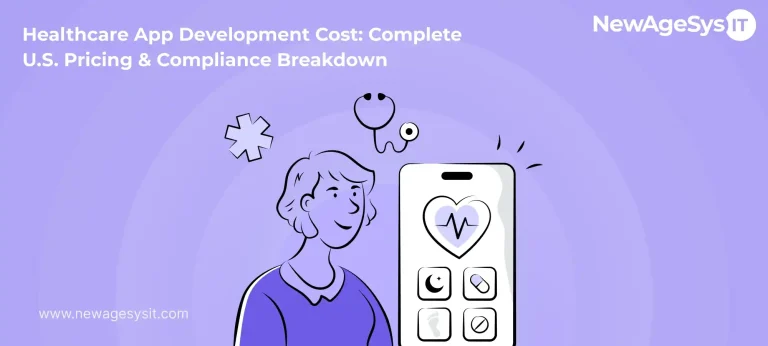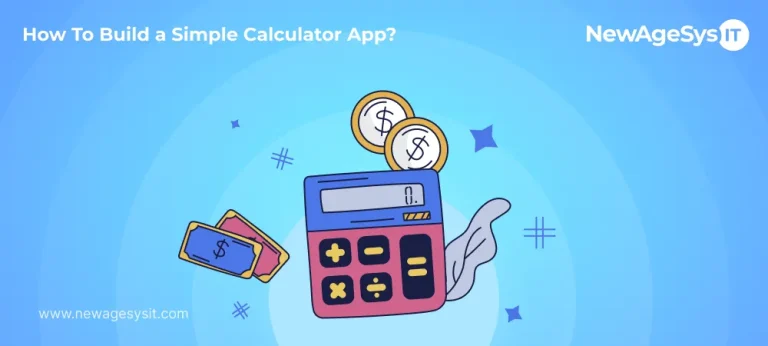| TL; DR Python remains the most popular language with 44.1% of developers using it, while Go is gaining appreciable traction at 8.8% (Statista). Python shines in AI/ML, data science, web development, and prototyping due to its vast libraries and strong community. Go excels in speed, performance, concurrency, and scalability, making it ideal for microservices and large-scale systems. Python is best suited for projects requiring analytics, visualization, and rapid development, while Go is ideal for high-performance, cloud-native, scalable, and concurrent systems. Both are open-source but serve different needs: Python for versatility, Go for efficiency. The choice should be about what fits your project goals—Python for versatility and mature ecosystems, Go for speed and concurrency at scale. |
The Internet forms a robust infrastructure that serves as a baseline for various systems to be built upon. While a common user doesn’t consider this much, good developers always make efforts to refine their code and applications further.
Python has topped the list of most used programming languages across the globe; however, Golang has begun taking new leaps in this phase. While Python is still ahead of the curve with 44.1% developers utilizing it for tasks, Go is winning more attention and has climbed the ladder with 8.8%, says Statista.
What makes Python & Go different from each other, and how do you choose the programming language that best suits your business needs? In this blog, we shall delve into the comparison between Golang Vs, Python, the advantages and disadvantages of Python and Go, and help you pick the right language for your upcoming project.
What is Python?
Python is a well-known general-purpose programming language that can steer the backend for web development, enable big data processing, involve high-end mathematical valuations, write system scripts, and also scale automation, for example, by using a SERP scraper.
Generally termed as ‘glue language’, Python allows front ends and backends of your app to work together efficiently. As a dynamically typed language created in 1991, it hasn’t quickly gained popularity as it has now. Python is recognized as a high-level interpreted language with a key focus on object-oriented programming. Additionally, it is a prime choice in several areas, such as data science and big data processing.
What is Golang?
Created in 2009, Golang, or Go, is a procedural programming language developed by Google. This was launched with the goal of facilitating the construction of its backend services. But, Go has now slowly moved beyond its initial goal. While deciding if Golang development is ideal for your project, these features should be considered:
- As a new language created by Google in the cloud computing era, it has specific, modern, and technological objectives.
- It should be considered as a portable language optimized for microservices architecture.
Benefits & Drawbacks of Using Python & Go
Go is functional, procedural, and concurrent, while Python is imperative, object-oriented, functional, and procedural. Likewise, they have numerous advantages that distinguish them from other programming languages. Let’s learn and analyze how each language benefits you the most.
Benefits of Using Python
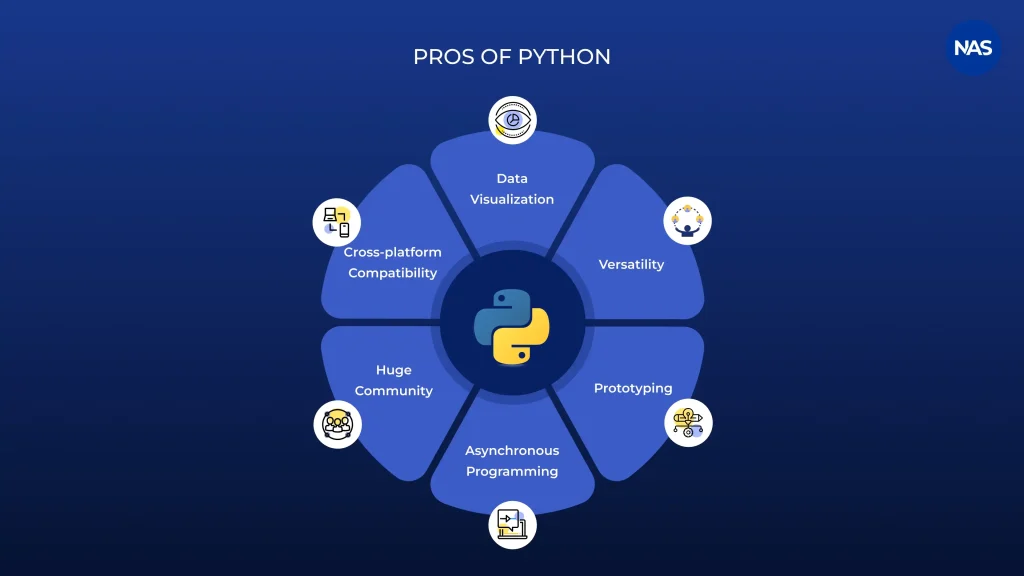
Data Visualization
Python is an ideal technology for apps that require complex data analysis and visualization features. Huge fintech companies and tech organizations use Python libraries, namely Seaborn, Matplotlib, and ggplot, to build dynamic and easy-to-read graphic reports.
Versatility
Python is highly versatile compared to Go. It offers a wide range of frameworks and libraries that enable you to adopt IoT, Machine Learning, or web development, as well as scale automation within your organization.
Prototyping
Python has great agility and simplicity that allows for the utilization of its development to build prototypes. With ease of code refactoring and an improved development process, it provides quality-specific prototypes that can be turned into a final product.
Asynchronous Programming
Asynchronous programming allows users to run code blocks separately and address bugs quickly and efficiently. Python and Go
Huge Community
In Python Vs. Go, Python is a matured programming language with a vast community of developers and contributors, with a significant role in language development. Additionally, many active developers are willing to share their experiences and tips on platforms like GitHub, thereby reducing the learning curve.
Cross-Platform Compatibility
Python is inherently cross-platform. This means that apps written in Python can run effortlessly across various OS versions. For example, Windows, macOS, and Linux, but with fewer code changes. Hence, organizations can easily deploy solutions across multiple environments without the need for extensive redevelopment.

Benefits of Using Go
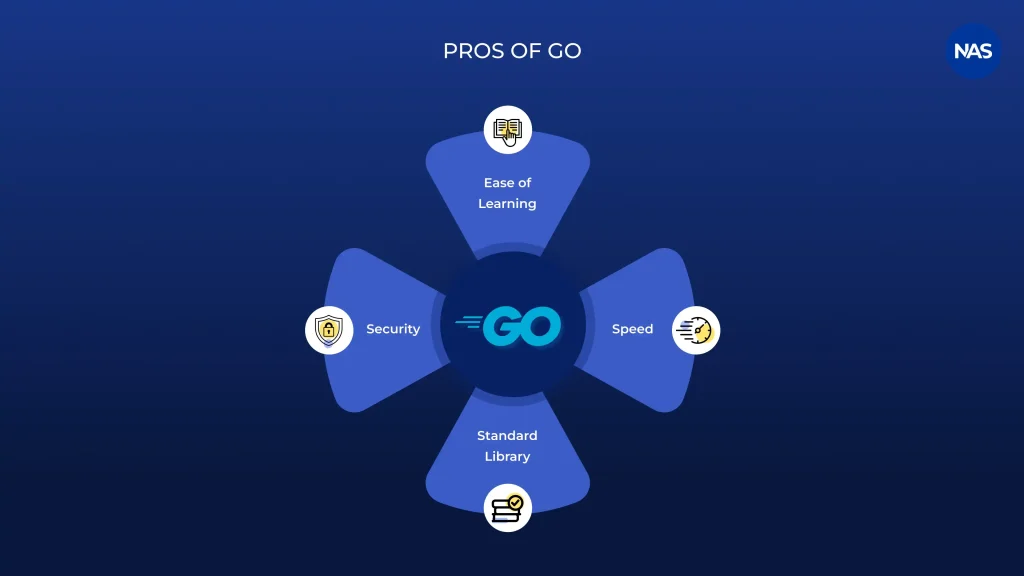
Ease of Learning
For developers who have been particularly involved with C++ and C#, Go is very easy to learn. Go’s syntax is relatively simple, which makes it an ideal pick for new users.
Speed
Golang also has high speed that lets you develop and compile quickly. Go gets compiled directly to machine code, giving it a significant advantage over other languages that rely on virtual runtimes. Consequently, developers can offer high-performance apps and write programs faster.
Security
Go ensures high-end security that is derived from its simplicity. As a statically typed language, Go doesn’t need a complex structure; it makes error detection effortless. Nevertheless, it has an integrated garbage collector, making the memory remain intact.
Standard Library
The language also has a standard library. Many other languages need additional secondary libraries that could produce conflicts among function names and add to the process complexity. Go’s feature-specific library has sufficient tools that make development flawless and faster.

Drawbacks of Using Python & Go
The Cons of Python
-Mobile App Development: Lack of support for native mobile application development.
–Ecosystem Maturity: Certain performance-centric domains lack robust libraries.
– Compilation and speed– could be slower in terms of execution.
– Code reusability/development efficiency– dynamic typing can result in maintenance overhead.
The Cons of Go
-Mobile Development: Weak support for mobile development, lacks strong native frameworks.
–Ecosystem Maturity: Still a young language, so it has few community resources and libraries.
–Compilation and speed– Strictly compiled and takes longer to compile, slowing iteration.
–Code reusability/development efficiency– Limited code reusability patterns, which reduce development efficiency.
Go Vs Python Comparison Table: A Quick Glance
| Python | Go |
|---|---|
| Beginner-Friendly | Easy if you’re familiar with C or C++ |
| Highly versatile with a huge variety of libraries | Less versatile when compared to Python |
| Huge community support and error-solving knowledge | Evolving community with great concurrency support |
| Dynamically typed | Statically typed |
| Object-oriented, supports financial concepts | Mainly procedural, supports concurrency |
| Usually needs less code than Go | More verbose than Python |
| Automated garbage collection & typing | Automated garbage collection & typing |
| Slower than Go, not great for performance-centric apps | Fast performance compared to Java and C++ |
| Limited concurrency support | Great concurrency patterns |
| CPU/Memory profiling tools are basic | Powerful CPU profiling and memory tuning |
| Open-Source | Open-Source |
Python Vs. Go: Factors to Help You Choose
1. Performance
When considering Go vs Python performance, we refer to the runtime performance. Various tests show that Golang runs 30 times faster compared to Python. With concurrency support, Go executes calculations significantly quicker than Python.
💡And the winner in terms of Go vs Python performance? Golang.
2. Speed
Golang is a great choice as it delivers quick and frequent server-side script deployment. This is because of high-performing concurrency and parallelism. Golang is particularly well-suited for systems programming, particularly when it comes to speed comparisons among programming languages.
💡And the winner in Golang Vs Python in terms of speed? Golang.
3. Scraping
Considering Web Scraping, Golang Vs Python, Python is the best choice for quick prototyping, smaller projects, or if you focus on development ease and a vast library ecosystem. However, with highly concurrent scraping, performance-centric, and large-scale projects, Golang is the one you can rely on.
💡And the winner in terms of web scraping, Golang vs Python? Python for JS-heavy and flexible prototyping, whereas Go for large-scale, resource-efficient, and high-speed operations.
4. Scalability
When considering Golang Vs Python scalability, Go has outstanding parallelism and concurrency. Being developed by Google for Google, Golang was built to scale according to the company’s requirements. Python lacks multi-threading capabilities and concurrency, making it less scalable.
💡And the winner considering Golang Vs Python scalability? Golang.

5. Machine Learning
Choosing Golang for Machine Learning is a good choice among the tech community. Though Python is still leading, the performance and speed of Go have urged many developers to pick it for the next project. Using Go to build AI/ ML development projects is a favourable decision; however, the lack of enough Golang frameworks makes developers move towards Python.
💡And the winner in terms of Machine Learning? Python.
6. Web Frameworks
Python has a vast array of frameworks and libraries that scale and simplify software development. Flask and Django are some advanced frameworks used extensively for web development. Hence, if you wish to build applications in a reduced time, you can hire dedicated developers for Python. To the contrary, Golang doesn’t have any ingrained framework used for Go-based projects.
💡And the winner in terms of web frameworks? Python.
7. Libraries
Being in the market for many years, Python has welcomed many companies and users alike. With a large community of supporters that actively engages with packages, modules, and libraries, Python is a go-to language. However, as a relatively new technology with minimal support, Go is in the process of developing a great community for itself.
💡And the winner in terms of libraries? Python.
8. Prototyping
Python is an excellent choice for prototyping as it is dynamic. Even without knowing how it works, a basic understanding is enough to build a prototype quickly and raise adequate funds for development. Being static, Go is stricter in terms of compilation. Even if you’re building a simple prototype, you can’t make it with the basics.
💡And the winner in terms of prototyping? Python.
9. Web Development
Go needs more coding, which makes the process longer and more prone to errors. However, Python offers a wider range of mature frameworks for web app development. Go has one major advantage: being a statically typed language, it goes for early error detection, unlike Python, which can catch errors at runtime.
💡And the winner in terms of Golang Vs Python for web development? Python.
10. Data Science
Python is the most preferred language when talking about data science and data analytics services. It has a vast ecosystem built upon and extended with numerous libraries and frameworks to support operations such as statistics, mathematics, AI, and distributed processes. Go has been evolving in terms of data science, but it still needs community support.
💡And the winner in terms of data science? Python.
Some Major Real-Time Applications that Use Golang & Python
Applications That Use Golang
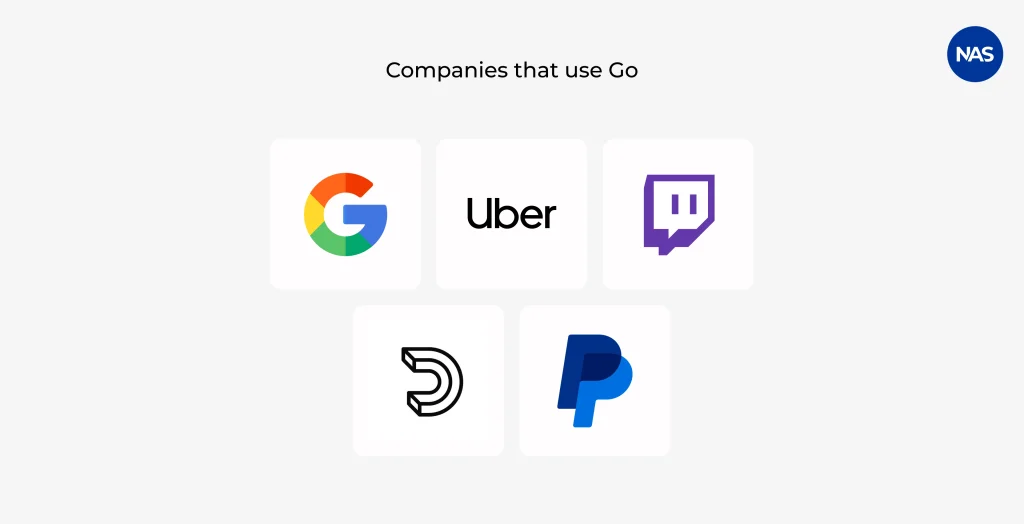
As designed by Google, Golang is largely used for its internal projects. For example, Google Chrome and Google Earth were developed this way. Go is also used in Google App Engine and YouTube.
Uber
Uber is one of the biggest companies that uses Go. This is used for a geofence service that provides the user’s location and product availability. Geofencing helps define an area with specific requirements precisely and implement dynamic pricing.
Twitch
Go is used in Twitch for most loaded systems. Due to the security, simplicity, and high efficiency, Go manages the challenges encountered during live video display and simultaneous chats for multiple users.
Dailymotion
This is a video streaming website built with Go for automating APIs. The language has been helpful in carrying out numerous automation tests, thereby avoiding massive loads.
PayPal
Golang has also helped in the development of PayPal’s platform with a secure payment solution. When discussing performance, Go has been beneficial in implementing built-in concurrency capabilities and handling large volumes of transactions concurrently, enabling efficient processing.
Applications That Use Python
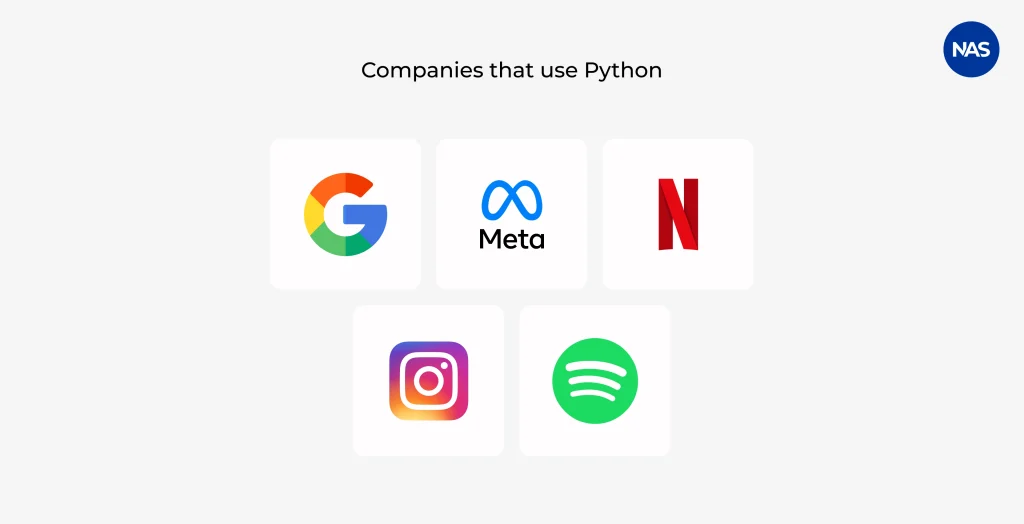
Google uses Python for the YouTube backend and machine learning, where TensorFlow began as a Python library. Due to the rapid prototyping and a clean syntax, Python is suited for Google’s systems.
Meta
Python is easy to integrate with other languages and performs faster, making it an ideal choice for Instagram backend, automation scripts, and the AI/ML pipelines.
Netflix
Netflix’s content management and recommendation systems and data pipelines are built with Python. With its powerful libraries, such as Scikit-learn and Pandas, the platform enables effective analysis of large datasets.
The properties like scalability (Django) and readability (Python) have been helpful for Instagram to manage massive traffic. Python has been a game-changer in managing millions of user requests, with real-time notifications.
Spotify
Spotify uses Python for music recommendation algorithms and backend APIs. The data libraries of Python enable Spotify to process massive sets effortlessly.
Golang Vs Python: Which is Better?
So, what should you choose, Go or Python? Answering this needs a careful consideration of your project’s specifics. Python is a highly desirable language for data analytics, Deep Learning, web development, and AI-specific projects. Go is a Go-to language in terms of scalability, concurrency, speed, and performance. The major aspect that Python stands out is the large number of frameworks and libraries that support development.
Finally, making a decision between Go Vs Python in the young age of Golang doesn’t seem fair. Go has been capable of driving large companies and building a small yet supportive community in a few years. Python is also a well-known and popular language commonly used for gaming, e-commerce, and complex business applications. When you need a language that can manage huge amounts of data and high-end visualization, Python is for you.
Summing Up
There’s a lot to learn while you think about Golang Vs Python. Both are different in terms of strengths and weaknesses, and their use in each business can vary based on the objective or scope. That said, when you look for better speed, performance, and scalability, Golang proves to be better. Although Python lags behind in terms of performance, it offers a wide range of frameworks and libraries, as well as an active community that consistently contributes.
If you’re looking to partner with a Golang development company or specifically looking for Python development services, NewAgeSys offers the leading solutions and consulting services to let you scale your development. With years of experience, we have the proficiency in advising you on your next move to make a well-laid decision. To learn more about the services we provide, contact us today!
FAQ:
1. Is Golang better than Python?
It depends on your requirements and the parameters you consider for your development. When thinking about Golang vs. Python performance and speed, Golang is generally considered the better choice. However, when considering the active community, libraries, and frameworks, Python is the clear choice.
2. When to use Golang over Python?
Go is ideal when you need scalability, performance, and concurrency to be the major drivers. It beats Python in case you need highly performing backends, real-time systems, microservices, cloud-native applications, or large-scale concurrent applications. Go has a highly optimized speed, efficient resource use, and a reliable concurrency model.
3. Golang vs Python: Which is better?
Golang, as of now, misses certain advantages that Python can offer, like massive libraries, so you can’t replace Python completely. Nevertheless, Python is a great tool for developers to create simple and quick prototypes, which can’t be achieved by Golang.
4. Is Golang faster than Python?
It completely depends on the application. According to some recent studies, Go could be 40 times faster compared to Python.
5. Is Golang better than Python for backend development?
Considering Golang vs Python for backend, Go is usually better for backend systems that demand concurrency, scalability, and high-end performance, say, APIs, real-time applications, and microservices. However, Python is ideal for quicker prototyping, data-driven backends, and AI/ML integrations due to its huge ecosystem of frameworks and libraries.



